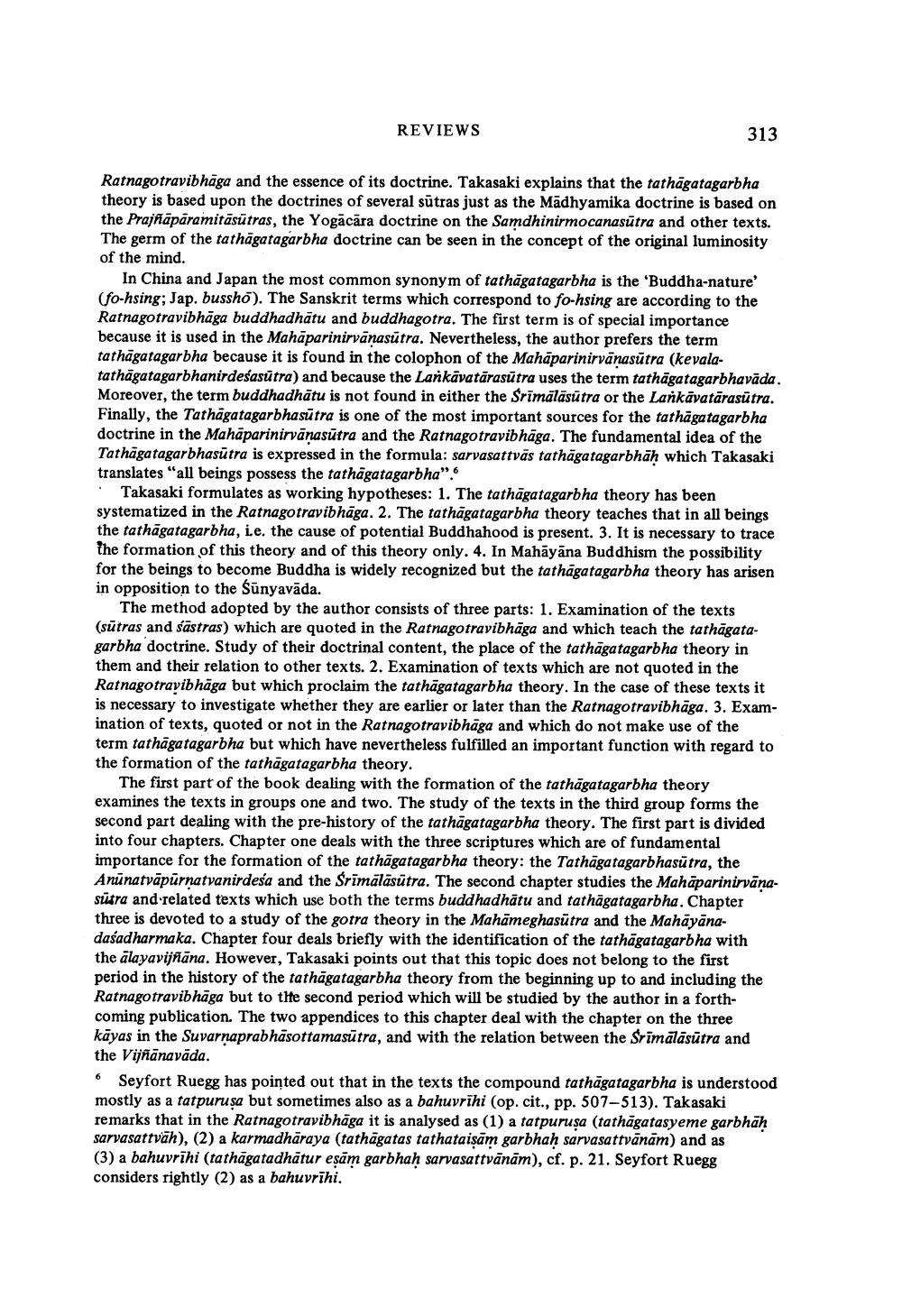________________
REVIEWS
313
Ratnagotravibhāga and the essence of its doctrine. Takasaki explains that the tathāgatagarbha theory is based upon the doctrines of several sutras just as the Madhyamika doctrine is based on the Prajñāpāramitāsutras, the Yogacara doctrine on the Samdhinirmocanasutra and other texts. The germ of the tathāgatagarbha doctrine can be seen in the concept of the original luminosity of the mind.
In China and Japan the most common synonym of tathāgatagarbha is the 'Buddha-nature' (fo-hsing; Jap. bussho). The Sanskrit terms which correspond to fo-hsing are according to the Ratnagotravibhāga buddhadhātu and buddhagotra. The first term is of special importance because it is used in the Mahaparinirvanasutra. Nevertheless, the author prefers the term tathāgatagarbha because it is found in the colophon of the Mahaparinirvanasutra (kevalatathāgatagarbhanirdeśasutra) and because the Lankavatarasutra uses the term tathāgatagarbhavāda. Moreover, the term buddhadhātu is not found in either the Srimäläsutra or the Lankavatārasūtra. Finally, the Tathāgatagarbhasutra is one of the most important sources for the tathāgatagarbha doctrine in the Mahāparinirvānasutra and the Ratnago travibhāga. The fundamental idea of the Tathāgatagarbhasutra is expressed in the formula: sarvasattvas tathāgatagarbhaḥ which Takasaki translates "all beings possess the tathāgatagarbha".
Takasaki formulates as working hypotheses: 1. The tathāgatagarbha theory has been systematized in the Ratnago travibhāga. 2. The tathāgatagarbha theory teaches that in all beings the tathāgatagarbha, i.e. the cause of potential Buddhahood is present. 3. It is necessary to trace the formation of this theory and of this theory only. 4. In Mahayana Buddhism the possibility for the beings to become Buddha is widely recognized but the tathāgatagarbha theory has arisen in opposition to the Sunyavāda.
The method adopted by the author consists of three parts: 1. Examination of the texts (sutras and sastras) which are quoted in the Ratnago travibhāga and which teach the tathāgatagarbha doctrine. Study of their doctrinal content, the place of the tathāgatagarbha theory in them and their relation to other texts. 2. Examination of texts which are not quoted in the Ratnagotravibhāga but which proclaim the tathāgatagarbha theory. In the case of these texts it is necessary to investigate whether they are earlier or later than the Ratnagotravibhāga. 3. Examination of texts, quoted or not in the Ratnagotravibhāga and which do not make use of the term tathāgatagarbha but which have nevertheless fulfilled an important function with regard to the formation of the tathāgatagarbha theory.
The first part of the book dealing with the formation of the tathāgatagarbha theory examines the texts in groups one and two. The study of the texts in the third group forms the second part dealing with the pre-history of the tathāgatagarbha theory. The first part is divided into four chapters. Chapter one deals with the three scriptures which are of fundamental importance for the formation of the tathagatagarbha theory: the Tathāgatagarbhasutra, the Anunatvāpūrṇatvanirdesa and the Śrīmālāsūtra. The second chapter studies the Mahāparinirvāṇasutra and related texts which use both the terms buddhadhātu and tathāgatagarbha. Chapter three is devoted to a study of the gotra theory in the Mahämeghasutra and the Mahāyānadasadharmaka. Chapter four deals briefly with the identification of the tathagatagarbha with the alayavijñāna. However, Takasaki points out that this topic does not belong to the first period in the history of the tathāgatagarbha theory from the beginning up to and including the Ratnagotravibhāga but to the second period which will be studied by the author in a forthcoming publication. The two appendices to this chapter deal with the chapter on the three kayas in the Suvarnaprabhāsottamasutra, and with the relation between the Śrīmālāsūtra and the Vijñānavāda.
6
Seyfort Ruegg has pointed out that in the texts the compound tathāgatagarbha is understood mostly as a tatpuruşa but sometimes also as a bahuvrihi (op. cit., pp. 507-513). Takasaki remarks that in the Ratnagotravibhāga it is analysed as (1) a tatpuruşa (tathāgatasyeme garbhāḥ sarvasattväh), (2) a karmadharaya (tathāgatas tathataiṣām garbhaḥ sarvasattvānām) and as (3) a bahuvrihi (tathāgatadhatur eṣām garbhaḥ sarvasattvānām), cf. p. 21. Seyfort Ruegg considers rightly (2) as a bahuvrihi.




